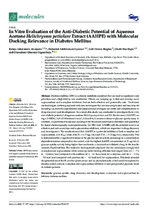| dc.contributor.author | Akinyede, Kolajo Adedamola | |
| dc.contributor.author | Oyewusi, Habeebat Adekilekun | |
| dc.contributor.author | Hughes, Gail Denise | |
| dc.contributor.author | Ekpo, Okobi Eko | |
| dc.date.accessioned | 2022-01-17T08:28:06Z | |
| dc.date.available | 2022-01-17T08:28:06Z | |
| dc.date.issued | 2021-12 | |
| dc.identifier.citation | Akinyede, K.A.; Oyewusi, H.A.; Hughes, G.D.; Ekpo, O.E.; Oguntibeju, O.O. In Vitro Evaluation of the Anti-Diabetic Potential of Aqueous Acetone Helichrysum petiolare Extract (AAHPE) with Molecular Docking Relevance in Diabetes Mellitus. Molecules 2022, 27, 155. https://doi.org/10.3390/ molecules27010155 | en_US |
| dc.identifier.uri | https://doi.org/10.3390/ molecules27010155 | |
| dc.identifier.uri | http://hdl.handle.net/10566/7097 | |
| dc.description.abstract | Diabetes mellitus (DM) is a chronic metabolic condition that can lead to significant complications and a high fatality rate worldwide. Efforts are ramping up to find and develop novel
α-glucosidase and α-amylase inhibitors that are both effective and potentially safe. Traditional
methodologies are being replaced with new techniques that are less complicated and less time demanding; yet, both the experimental and computational strategies are viable and complementary in
drug discovery and development. As a result, this study was conducted to investigate the in vitro
anti-diabetic potential of aqueous acetone Helichrysum petiolare and B.L Burtt extract (AAHPE) using a 2-NBDG, 2-(N-(7-Nitrobenz-2-oxa-1,3-diazol-4-yl) amino)-2-deoxy-D-glucose uptake assay. In
addition, we performed molecular docking of the flavonoid constituents identified and quantified
by liquid chromatography-mass spectrometry (LC-MS) from AAHPE with the potential to serve as
effective and safe α-amylase and α-glucosidase inhibitors, which are important in drug discovery
and development. The results showed that AAHPE is a potential inhibitor of both α-amylase and
α-glucosidase, with IC50 values of 46.50 ± 6.17 (µg/mL) and 37.81 ± 5.15 (µg/mL), respectively. This
is demonstrated by a significant increase in the glucose uptake activity percentage in a concentrationdependent manner compared to the control, with the highest AAHPE concentration of 75 µg/mL of
glucose uptake activity being higher than metformin, a standard anti-diabetic drug, in the insulinresistant HepG2 cell line. The molecular docking results displayed that the constituents strongly bind
α-amylase and α-glucosidase while achieving better binding affinities that ranged from ∆G = −7.2
to −9.6 kcal/mol (compared with acarbose ∆G = −6.1 kcal/mol) for α-amylase, and ∆G = −7.3 to
−9.0 kcal/mol (compared with acarbose ∆G = −6.3 kcal/mol) for α-glucosidase. This study revealed
the potential use of the H. petiolare plant extract and its phytochemicals, which could be explored to
develop potent and safe α-amylase and α-glucosidase inhibitors to treat postprandial glycemic levels
in diabetic patients. | en_US |
| dc.language.iso | en | en_US |
| dc.publisher | MDPI | en_US |
| dc.subject | Glucose uptake | en_US |
| dc.subject | Drug discovery and development | en_US |
| dc.subject | α-amylase and α-glucosidase inhibitors | en_US |
| dc.subject | Diabetes Mellitus | en_US |
| dc.subject | Chronic condition | en_US |
| dc.title | In vitro evaluation of the anti-diabetic potential of aqueous acetone Helichrysum petiolare extract (AAHPE) with molecular docking relevance in diabetes mellitus | en_US |
| dc.type | Article | en_US |

